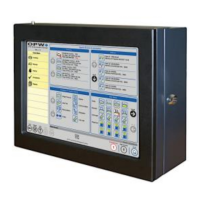8.4.1 Calculating Product Offset
You can calculate product offset for a probe that is not installed in the
center of a "pitched" tank. Pitch is the tilt of a tank along its horizontal
axis. Some tanks are intentionally installed with one end lower than
the other to allow water and sediment to collect at the low end, while
clear product is drawn from the high end. Tank settling can also cause
pitch. The rate of pitch can be measured by using a dipstick to
measure the level of product at two points (preferably opposite ends)
of the tank (see Figure on right).
The product depth at the deep (lower) end of the tank is value “A.”
The product depth at the shallow (higher) end is value “B.” The
distance between the two measuring points is “C.”
The formula for pitch is:
(A-B)/C
For example:
(46"-40")/120" = 6"/120" = 0.05”
To calculate the product offset, measure value “D,” the distance of the
probe from the center of the tank. The formula for product offset is “D”
x pitch. For the above example, 36” x 0.05 = 1.8”.
If the probe is located closer to the shallow end of the tank, the
product offset is positive; for the example, 1.8”.
If the probe is located closer to the deep end of the tank, the product
offset is negative; for the example, -1.8”.
Figure 8-5 Calculating Probe Offset

